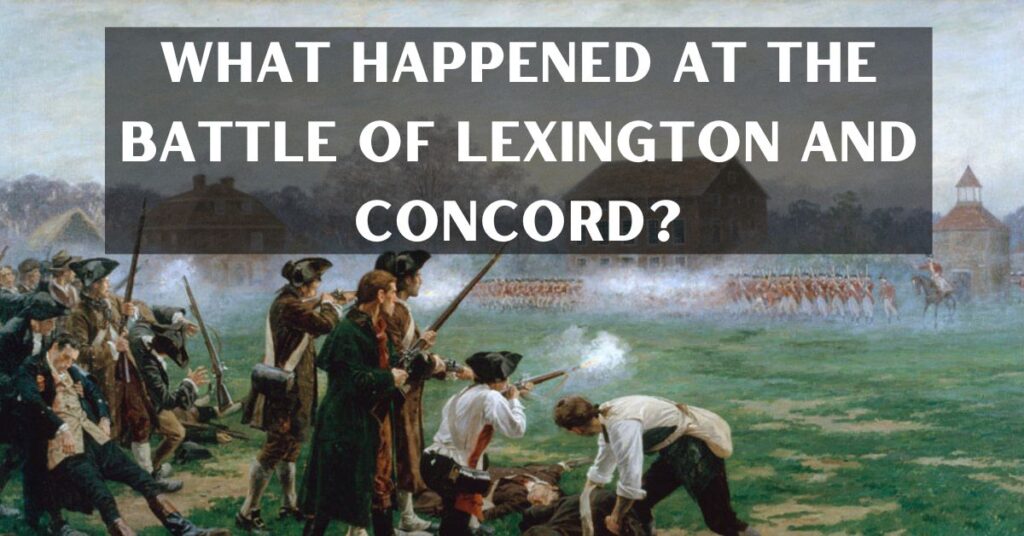The Battle of Lexington and Concord marked the beginning of the American Revolutionary War, a pivotal event that would change the course of history. In this article, we delve into the background, events, and aftermath of these crucial battles, exploring their significance in the larger context of the American Revolution. We will also provide a glimpse into the battlefields as they stand today, highlighting the landmarks and monuments that commemorate the bravery and sacrifice of the men and women who fought for American independence. Join us on this journey through history as we uncover the facts, stories, and lasting impact of the Battles of Lexington and Concord.
Table of Contents
The Prelude to the Battle
As tensions between the British government and the American colonies escalated, the stage was set for a confrontation that would forever change the course of history. The Battle of Lexington and Concord marked the beginning of the Revolutionary War, a conflict that ultimately led to the birth of a new nation. In this section, we will explore the events leading up to these critical battles, shedding light on the political and social climate of the time, as well as the preparedness of the colonial militias who would soon face the might of the British Army. As we delve into the prelude to the Battle of Lexington and Concord, we will begin to understand the complex factors that ignited the spark of revolution.

When was the Battle of Lexington and Concord?
The Battles of Lexington and Concord took place on April 19, 1775, a fateful day that saw the first military engagements between British forces and American colonists. These battles signaled the beginning of the Revolutionary War, which would rage on for eight long years until the Treaty of Paris was signed in 1783, ultimately recognizing the United States as an independent nation.
The role of colonial militias
In the lead-up to the battles, the American colonies had established their own militias comprised of ordinary citizens who were ready to take up arms in defense of their rights and liberties. These militias played a crucial role in the early stages of the Revolutionary War, as they provided the colonies with an organized fighting force that could quickly respond to British aggression.
Training and equipping these militias varied from colony to colony, but many were well-prepared to face the British forces. Some members of the militias were even veterans of previous colonial wars, bringing valuable military experience to their ranks. These militias were under the command of locally-elected leaders, who often coordinated their efforts with other nearby militias, creating a network of support and communication.
As tensions between the colonies and the British government grew, the colonial militias played a vital role in securing arms, ammunition, and other supplies, storing them in secret locations away from British control. This strategy would prove crucial to the American cause during the Battles of Lexington and Concord, as it allowed the militias to engage the British forces effectively, despite their numerical disadvantage.
In conclusion, the colonial militias were instrumental in setting the stage for the Battles of Lexington and Concord, demonstrating the resolve and determination of the American colonists to stand up against British tyranny. The events that unfolded on April 19, 1775, would serve as a testament to the courage and resourcefulness of these citizen-soldiers, whose actions would ultimately contribute to the birth of a new nation.
The Battle of Lexington
The early morning hours of April 19, 1775, brought a tense confrontation to the sleepy town of Lexington, Massachusetts. As the first battle of the Revolutionary War, the clash in Lexington would set the stage for the struggle that followed, revealing the determination of the American colonists to defend their rights and resist British authority. In this section, we will explore the events that unfolded during the Battle of Lexington, including the key players involved, the tactics employed, and the outcome that would shape the course of the war.

Who won the Battle of Lexington?
The outcome of the Battle of Lexington is somewhat ambiguous, as both the British and the American colonists claimed victory. While the British were successful in dispersing the colonial militia with a show of force, the colonists demonstrated their willingness to resist, which ultimately had a lasting impact on the Revolutionary War. In the broader context of the conflict, many historians view the Battle of Lexington as a moral victory for the colonists, as it marked the beginning of their fight for independence.
What happened in the Battle of Lexington?
On the night of April 18, 1775, British troops, led by Lieutenant Colonel Francis Smith, were dispatched from Boston to confiscate weapons and ammunition stored by the colonial militia in Concord. Alerted to the British movement by Paul Revere and other riders, the Lexington militia, under the command of Captain John Parker, assembled on the town’s common to intercept the British forces.
As the sun began to rise on April 19, approximately 700 British soldiers approached Lexington, where they encountered a small group of 77 armed militiamen awaiting their arrival. Although the exact details remain unclear, a shot rang out—now famously known as “the shot heard ’round the world”—and the two sides engaged in a brief but fierce skirmish.
The outnumbered colonial militia suffered eight fatalities and ten wounded, while the British only had one soldier injured. The remaining militiamen retreated as the British forces continued their march towards Concord. Despite the apparent British tactical success, the American colonists had taken a stand, sending a powerful message that they were ready to defend their rights and liberties. This initial engagement set the stage for a long and arduous conflict, with the Battle of Lexington marking the beginning of the Revolutionary War.
The Battle of Concord
Following the confrontation in Lexington, the British forces pressed on toward their primary objective: the town of Concord. Unbeknownst to them, the events that were about to unfold would not only demonstrate the resourcefulness and resilience of the colonial militia but also mark a turning point in the struggle for American independence. In this section, we will delve into the Battle of Concord, examining the strategies employed by both sides, the key moments of the engagement, and the lasting consequences of this pivotal encounter.

Who won the Battle of Concord?
The Battle of Concord is considered a victory for the American colonists. Although the British forces had initially dispersed the colonial militia in Lexington, the tide turned in Concord, where the colonists’ persistence and coordination forced the British to retreat. The Battle of Concord demonstrated the colonists’ ability to stand up to the well-trained British Army, bolstering their resolve and inspiring others to join the fight for independence.
What happened in the Battle of Concord?
As the British forces marched towards Concord, they encountered a rapidly growing number of colonial militiamen who had been alerted by the earlier events in Lexington. By the time the British troops reached Concord, they found themselves facing an organized and determined militia force.
The British began searching for the arms and ammunition they believed to be hidden in the town. However, much of the supplies had already been moved to safety, thanks to the efforts of local patriots who had been warned of the impending raid. Frustrated by their inability to locate the stockpiles, the British troops set fire to a small portion of the town, drawing the attention of the colonial militia.
The militiamen, now numbering in the thousands, engaged the British forces at the North Bridge in Concord. The ensuing firefight, known as “the shot heard ’round the world,” resulted in the first British casualties of the war. Realizing that they were heavily outnumbered and facing mounting resistance, the British forces began their long and harrowing retreat back to Boston.
During the retreat, the colonial militia, now emboldened by their success at Concord, pursued and harassed the British troops, inflicting further casualties. The British forces, exhausted and demoralized, finally reached the safety of Boston, but the day’s events had made it clear that the American colonies were prepared to resist British authority with force. The Battles of Lexington and Concord marked the beginning of a long and arduous struggle for American independence.
The Battles’ Aftermath and Significance
The Battles of Lexington and Concord not only marked the beginning of the Revolutionary War but also had profound implications for both the American colonies and the British Empire. The events of April 19, 1775, would resonate far beyond the towns of Lexington and Concord, shaping the course of history and laying the groundwork for the birth of a new nation. In this section, we will examine the aftermath of these pivotal battles, exploring their immediate consequences, the lessons learned by both sides, and their enduring significance in the larger context of the American Revolution.
The impact on the Revolutionary War
The Battles of Lexington and Concord had a profound impact on the Revolutionary War. They served as a wake-up call for both the American colonies and the British government, making it clear that the conflict between them had escalated beyond political disagreements and into open warfare. The battles also galvanized support for the American cause, as many colonists who had been on the fence about the prospect of armed resistance now rallied behind the call for independence. These events set the stage for the formation of the Continental Army, led by George Washington, which would go on to challenge the British forces in a protracted and hard-fought war.
Battles of Lexington and Concord facts
The battles of Lexington and Concord produced several interesting facts that provide insight into the character and nature of the conflict:
- The famous “shot heard ’round the world” remains a mystery, as no one knows who fired the first shot at Lexington.
- Paul Revere, William Dawes, and Samuel Prescott were responsible for warning the colonists of the British advance, with Revere’s ride becoming an iconic symbol of American patriotism.
- British casualties during their retreat from Concord to Boston totaled around 273, while American casualties were approximately 95.
The role of the battles in American history
The Battles of Lexington and Concord hold a special place in American history as the opening chapter of the Revolutionary War. They demonstrated the colonists’ willingness to stand up to British tyranny and defend their rights, even in the face of overwhelming odds. The battles also set a precedent for the American militia system, which would play a crucial role throughout the war, as ordinary citizens from all walks of life took up arms in defense of their country.
The legacy of Lexington and Concord can still be felt today, as the battles are commemorated annually on Patriots’ Day, a holiday celebrated in Massachusetts, Maine, and Wisconsin. The events of April 19, 1775, serve as a reminder of the sacrifices made by the American colonists in their quest for independence and freedom, and their determination to stand against oppression, no matter the cost.

A Glimpse at the Battlefields Today
More than two centuries have passed since the Battles of Lexington and Concord, yet the sites where these historic events unfolded continue to captivate and inspire visitors from around the world. Today, these battlefields stand as monuments to the courage, determination, and sacrifice of the men and women who played a pivotal role in shaping the course of American history. In this section, we will take a virtual tour of the battlefields as they exist today, exploring the landmarks, monuments, and educational opportunities that make these sites an essential destination for history enthusiasts and curious travelers alike.
Battles of Lexington and Concord map
A visit to the battlefields of Lexington and Concord allows you to walk in the footsteps of the patriots who fought for American independence. These historic sites, located just a short drive from Boston, are connected by the Battle Road, a 5.5-mile-long stretch that traces the path taken by the British troops during their fateful expedition. The Minute Man National Historical Park encompasses much of the area, providing visitors with detailed maps and information to guide them on their journey through history.
Visiting the historic sites
When exploring the battlefields of Lexington and Concord, you’ll encounter numerous landmarks and monuments that pay tribute to the events that took place there:
Lexington Green
This historic common in Lexington is where the first shots of the Revolutionary War were fired. A statue of Captain John Parker, the leader of the Lexington militia, stands proudly on the green, commemorating the bravery of the colonists who faced the British forces.

North Bridge
Located in Concord, the North Bridge is the site of the “shot heard ’round the world.” Today, a replica of the original bridge stands, along with the Minute Man statue and the Obelisk monument, both dedicated to the memory of the American militiamen who fought there.

The Hancock-Clarke House and the Paul Revere Capture Site
The Hancock-Clarke House in Lexington is where John Hancock and Samuel Adams were staying on the night of Paul Revere’s famous ride. The Paul Revere Capture Site, situated along the Battle Road, marks the spot where Revere was captured by British troops during his attempt to warn Hancock and Adams.
The Old Manse
Located near the North Bridge, the Old Manse is a historic house museum that was once home to American transcendentalists Ralph Waldo Emerson and Nathaniel Hawthorne. The house offers a glimpse into the lives of these literary giants and provides stunning views of the North Bridge and the surrounding landscape.
Conclusion
In conclusion, the Battles of Lexington and Concord hold a significant place in American history as the opening conflicts of the Revolutionary War. These events showcased the courage and determination of the colonists, who stood up against British tyranny and laid the groundwork for the eventual establishment of the United States. Today, the historic sites of Lexington and Concord offer visitors a chance to step back in time and immerse themselves in the extraordinary story of America’s fight for independence. By exploring the battlefields and landmarks, we can gain a deeper understanding of the sacrifices made by the early patriots and appreciate the enduring legacy of their actions in shaping the nation we know today.

Joyce Ann Tyldesley is a renowned British archaeologist, Egyptologist, writer, and broadcaster.






